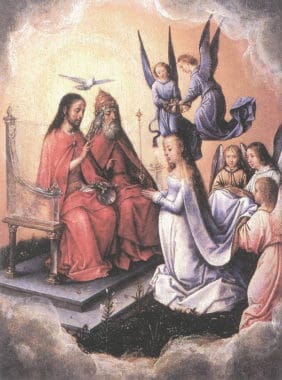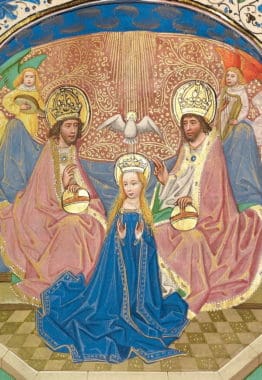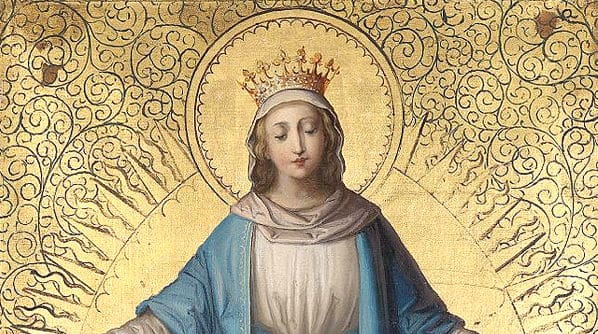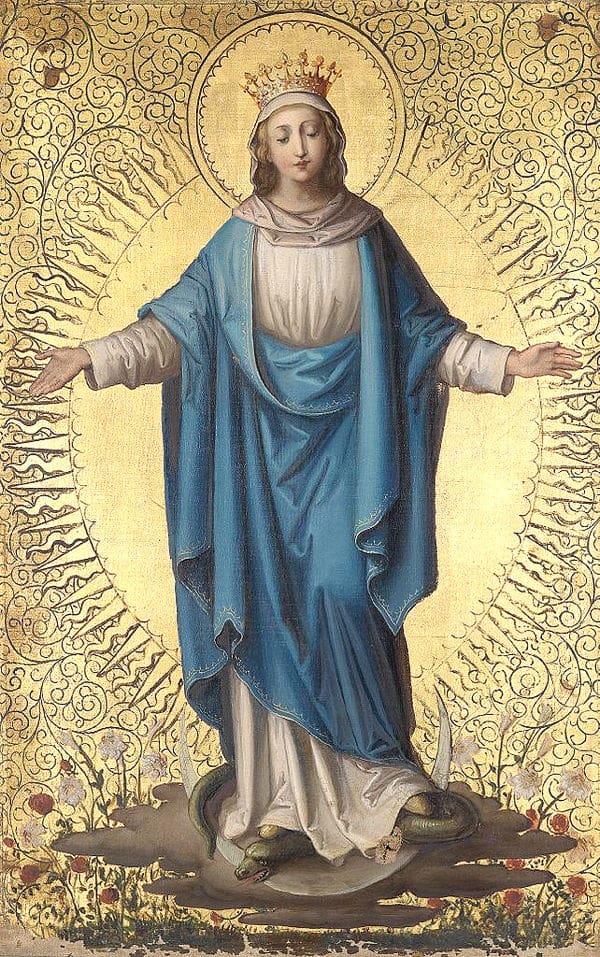“Hail Holy Queen”
Millions of times a day at the end of every Rosary, Mary is hailed as the “holy Queen” in whom we find “our life, our sweetness and our hope.” This reality is proof enough that the Church does not want her children to ever forget how important our heavenly Queen is in the life of Christians.
Queenship is not very popular in the modern world that has sought to liberate itself from concrete traditional forms of authority. But, historically, nations and cultures have never been so united than under a beloved king or queen whose authority was seen as a familial responsibility and a gift from God . . . to see God’s plan fulfilled in every aspect of society. When this reigned in the world, it was called Christendom. Now we live in the age that is characterized as “post-Christian” and rapidly heading toward all-out anti-Christian. But we see great hope in the world as we witness the unveiling of God’s plan concerning His Mother as revealed in the Book of the Apocalypse:
And a great portent appeared in heaven, a woman clothed with the sun, with
the moon under her feet, and on her head a crown of twelve stars. (Rev. 12:1)
This woman of the Apocalypse crowned with twelve stars is the woman we just celebrated last week as the Immaculate One assumed  body and soul into heaven. Mary’s assumption was her procession to her coronation, where she assumes the fullness of her mission as the Mediatrix of All Graces, a teaching the Church has always held about Mary and which has been given renewed attention by the papal Magisterium and laity over the last century. In short, this truth about Mary is tied into Mary’s inseparable role in the mystery of Redemption as Spouse of the Holy Spirit and the Mother of Christ. This movement of the Holy Spirit to give this reality of Mary renewed attention for our times is logical in light of the Church’s dogmatic definition of the Assumption by Venerable Pius XII in 1950 – because the next question is, “What does Mary do now that she is in heaven?” And the answer to this question is one of great joy because it deals with how the Mother of Christ relates to the rest of the world for whom Christ died. In other words, it answers the question: How does Mary relate to us?
body and soul into heaven. Mary’s assumption was her procession to her coronation, where she assumes the fullness of her mission as the Mediatrix of All Graces, a teaching the Church has always held about Mary and which has been given renewed attention by the papal Magisterium and laity over the last century. In short, this truth about Mary is tied into Mary’s inseparable role in the mystery of Redemption as Spouse of the Holy Spirit and the Mother of Christ. This movement of the Holy Spirit to give this reality of Mary renewed attention for our times is logical in light of the Church’s dogmatic definition of the Assumption by Venerable Pius XII in 1950 – because the next question is, “What does Mary do now that she is in heaven?” And the answer to this question is one of great joy because it deals with how the Mother of Christ relates to the rest of the world for whom Christ died. In other words, it answers the question: How does Mary relate to us?
Mary, as the Mediatrix of All Graces, has tremendous implications for every soul. First, for the unbaptized, it means that Mary is involved in obtaining the initial grace of conversion just as she mediated Christ’s first public miracle at Cana. The way St. John records the account implies that Jesus was there because of Mary and it was maternal love for the nuptials that moved her to notice what nobody else did. While historically this activity has often been a “covert operation” of Our Lady, we are witnessing in the modern world a thinning of that veil by the Holy Spirit. This is undeniably attested to by the millions upon millions of authentic conversions connected to places where Mary has appeared on the world stage—Lourdes and Fatima being just two examples.
Concerning the baptized, they receive the grace of salvation and Divine Sonship through the mediation of Mary. This is not difficult to understand when we remember that everything Mary did regarding the historical life of Jesus Christ, she continues to do for the Mystical Christ, the Church. Just as she physically formed the sacred body of the Jesus Christ and nurtured Him, so she does in the order of grace to those who make up His Mystical Body.
So, Mary is unceasingly active in the Christian soul, forming her Son within it at every stage. That is her greatest role. But Cana reveals that Mary is always on the lookout for those hidden needs of ours. Why? Because she loves us with an immaculate love! She desires us to present to her our earthly needs before her because she will use them ultimately for our salvation, just as the water that was turned into wine at Cana would be transformed ultimately into the salvific Blood of Jesus Christ at the Last Supper.
 This is why the Church always turns to Mary in times of peace and in times of darkness. As our “holy Queen” she is our life because she is Mother of the Source of Life, Jesus Christ. She is our sweetness because she always bears for us the Prince of Peace. She is our hope because she is the moon whose light always reminds us in dark nights of the light of the sun, Jesus Christ. And in a world desperately in need of peace and hope, let us be reminded of what Venerable Fulton Sheen said:
This is why the Church always turns to Mary in times of peace and in times of darkness. As our “holy Queen” she is our life because she is Mother of the Source of Life, Jesus Christ. She is our sweetness because she always bears for us the Prince of Peace. She is our hope because she is the moon whose light always reminds us in dark nights of the light of the sun, Jesus Christ. And in a world desperately in need of peace and hope, let us be reminded of what Venerable Fulton Sheen said:
It is particularly interesting that the theology of the Russians, before they were overshadowed by the cold heart of the anti-God, taught that, when the world rejected the Heavenly Father, He sent His Divine Son, Jesus Christ, to illumine the world. Then they went on to predict that, when the world would reject Our Lord as it has done today, on that Dark Night the light of His Mother would arise to illumine the darkness and lead the world to peace. The beautiful revelation of Our Blessed Mother at Fatima in Portugal from April to October 1917 was another proof of the Russian thesis that, when the world would fight against the Savior, He would send His Mother to save us. And her great revelation took place in the very month the Bolshevik Revolution began (The World’s First Love, Chapter 22)
Therefore, let us join our hope to that exercised by Pope Benedict XV, who guided the Church through the dark years of World War I, and saw Mary as having a critical role in the modern world in mediating peace:
Mother of the Prince of Peace, Mediatrix between rebellious man and the merciful God, she is the dawn of peace shining in the darkness of a world out of joint; she never ceases to implore her Son for peace although His hour is not yet come (Jn 2:4); she always intervenes on behalf of sorrowing humanity in the hour of danger; today she who is the mother of many orphans and our advocate in this tremendous catastrophe will most quickly hear our prayers.
When man has hardened his heart and hate has overrun the earth, when fire and sword convulse the world and make it resound with clash of arms and wailing, when human plans have proved misleading, and when all social wellbeing is upset, faith and history point to Mary as the only refuge, the all powerful intercessor, the Mediatrix of all grace. (Benedict XV, Allocution to the Consistory of 24 December 1915; Peter Howard, The Woman, 242)
As Venerable Fulton Sheen reminded us above, within two years of these words, which served as a kind of prayer, the great apparitions of Fatima began. Mary always listens to her children!
Mary, Queen of Peace, ORA PRO NOBIS!
+
Art for this post Hail, Holy Queen: Mondsichelmadonna (Woman of the Apocalypse), Circle of Leopold Kupelwieser, 19th century; Coronation of the Virgin, Michel Sittow, between 1496 and 1504; Detail from The Coronation of the Virgin, Willem Vrelant, early 1460s, PD-US published in the U.S. prior to January 1, 1923, all PD-US author’s life plus 100 years or less; Wikimedia Commons.






